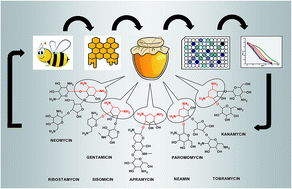Group-specific detection of 2-deoxystreptamine aminoglycosides in honey based on antibodies against ribostamycin†
Abstract
Aminoglycoside antibiotic ribostamycin (RS) was used as the immunizing hapten to evoke antibodies against the 2-deoxystreptamine (2-DOS) fragment for the first time. This moiety of the molecule is a generic structure combining a large number of aminoglycosides. Periodate-oxidized RS was conjugated to the protein carrier with a definite orientation with exposure of the 2-DOS determinant. Two immunogens BSA-RS and BSA-C6-RS were compared. The introduction of a C6 spacer arm between the hapten and the carrier resulted in raising antibodies with a better group specificity. The antibody specificity to the 2-DOS moiety allowed recognition of a wide spectrum of AGs, namely, RS, neomycin, neamin, paromomycin, gentamicin, sisomicin, kanamycin, tobramycin, and apramycin. The developed group-specific indirect competitive ELISA was capable of substituting a number of corresponding selective tests for detection of known analytes (with a LOD of 0.02–0.2 ng mL−1). For analysis of honey, a matrix imitator was developed to avoid honey interferences on immunoassay. The screening procedure including simple dilution of the honey sample and its analysis allowed us to reveal any of the mentioned analytes in honey at a 10 μg kg−1 level with a recovery rate of 78–120%.



 Please wait while we load your content...
Please wait while we load your content...